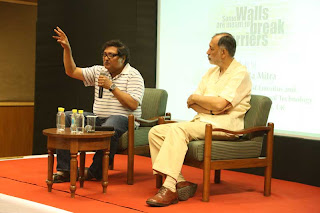Children learning themselves and teaching each other;
unsupervised, self-organized, minimally invasive education; curiosity driven
education; role of appreciation in self-motivated learning: these are the
keywords that can be heard when you listen to TED 2013 winner Dr. Sugata Mitra
and his wish of changing the future of education.
New Delhi, India: Where Dr. Mitra did his Master's and
PhD, and also started the famous “Hole in the Wall” experiment while he was
working with NIIT. People in New Delhi (various teachers, professors, thinkers,
ex-colleagues from NIIT, and other corporates) got an opportunity to talk to
him on April 6th 2013 about his ideas which won him a million
dollars in the TED Prize 2013.
Here are some excerpts and learnings:
1.
Power of admiration: Talking about his
experiment “The granny cloud”, Sugata explained how a granny is able to
encourage the child to try harder by simply admiring and appreciating a child’s
little achievements.
2.
Power of collaboration and group learning:
Sugata has been working on a concept called Self Organized Learning Environment
(SOLE) for quite some time. This involves students being given a big question,
and Then they search for the probable answer. If a student works alone, then there are
chances that he/she will digress onto something else and lose focus of the main
question. But if they are working in groups (3-4 students in a group is the ideal
team size), then they collaborate and discuss; and even if they do digress a
bit, they will come back to the main problem.
3.
Laggards in one discipline will be good in
some other discipline: All children will not have the same interest and
aptitude. If a child is not good in science then his natural interest might lie
in some other subject. A teacher needs to help the child find his strength and
encourage him to achieve goals in that area.
4.
Need to create space for experimentation:
All of us agree that the age of rote learning is far gone. Children’s learning
is most effective if they learn by experimenting by themselves. The Learning Environment
should allow them to search for information, experiment and learn, instead of receiving
pre-cooked knowledge from the teacher.
5.
8-12 is the best age to ignite curiosity
and inculcate the practice of self learning in children. By the time children
reach class 9th or 10th, the load of heavy text books and
scary exams increase on children. Our education system (he was referring to the
Indian education system, which may be very similar to that of other countries)
does not give them the time or space to experiment and have fun after 9th.
So 8 to 12 years (approximately the age when they are about to reach class 9th)
is the best time to engage them in finding answers to big questions. Teachers
need to promote inquisitiveness and revive curiosity in children.
6.
Engage the child, don’t supervise: to get
the best results from children, a teacher needs to engage with them in a
non-threatening environment. A child needs to feel comfortable expressing
himself and trying things the way he/she wants to. This brings out the best
creativity in the child.
7.
Kids love it if they know the topic is
relevant and not fake: Sugata gave many examples of topics which were
important in the Victorian era, but are not relevant in current times. Children
are excited to discuss and learn those things which they feel are relevant to
their life. (This I believe is very true, not only for children but to a
greater degree in higher education)
8.
Teacher’s role is to encourage and not to
teach: Sugata clarified that teachers will always be required and computers
may never fully replace teachers, but in the current age where so much of
knowledge is available on internet, the role of teachers needs to change in
such a way where they encourage and guide children on how to find the solution
instead of giving them the solution. This will also be useful for children when
they join the modern workforce and will be required to solve problems
themselves.
9.
The best of innovations happen when resources
are limited: Sugata mentioned that rich schools already have the best
resources: iPads for all students, self-sufficient labs and highly qualified
teachers. His experiments, however, have been focused on underprivileged
children in remote areas, who cannot get computers or good teachers. That is the
section towards which the “Hole in the Wall” experiment was targeted.
10.
Peer assessment is more valuable than
certification exam: This concept also emphasizes the importance of
collaboration over learning alone. If children discuss and collaborate
in groups, they actually develop better judgment about each other’s skills than any standard test can assess. The concept is being tried by
many MOOCs, not because it is better, but because it is the only way to conduct
assessment for a very large number of students. Sugata said that it’s his guess
that peer assessment will replace standard written assessments in the future.
Akhlesh Agarwal
